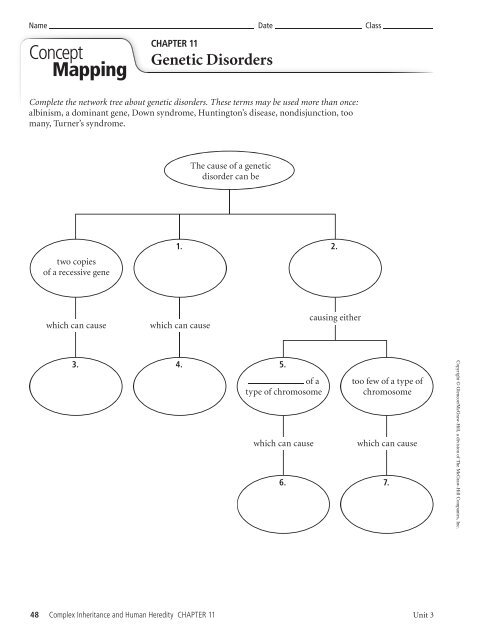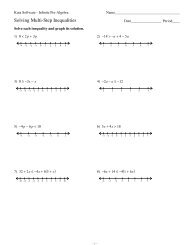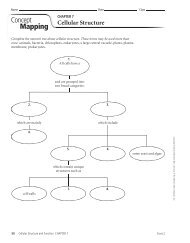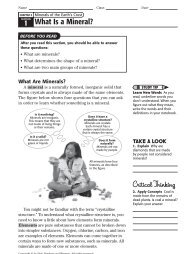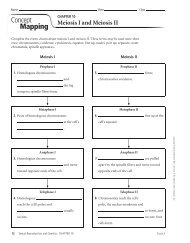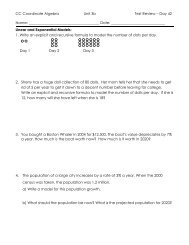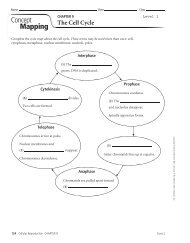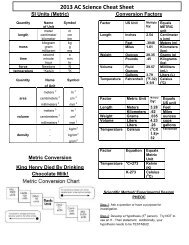Level 1 Study Guide for Chapter 11 - Cobb Learning
Level 1 Study Guide for Chapter 11 - Cobb Learning
Level 1 Study Guide for Chapter 11 - Cobb Learning
- No tags were found...
You also want an ePaper? Increase the reach of your titles
YUMPU automatically turns print PDFs into web optimized ePapers that Google loves.
Name Date ClassConceptMappingCHAPTER <strong>11</strong>Genetic DisordersComplete the network tree about genetic disorders. These terms may be used more than once:albinism, a dominant gene, Down syndrome, Huntington’s disease, nondisjunction, toomany, Turner’s syndrome.The cause of a geneticdisorder can betwo copiesof a recessive gene1.2.which can causewhich can causecausing either3. 4. 5.of atype of chromosomewhich can cause6.too few of a type ofchromosomewhich can cause7.Copyright © Glencoe/McGraw-Hill, a division of The McGraw-Hill Companies, Inc.48 Complex Inheritance and Human Heredity CHAPTER <strong>11</strong> Unit 3
Name Date Class<strong>Study</strong> <strong>Guide</strong>CHAPTER <strong>11</strong>Section 1: Basic Patterns of Human InheritanceIn your textbook, read about basic patterns of human inheritance.Use the terms below to complete the passage. These terms may be used more than once.albinism alleles cystic fibrosis dominantheterozygous homozygous pedigree recessiveA (1)shows the inheritance of a particular trait overseveral generations. An organism with two of the same (2)<strong>for</strong>a particular trait is said to be (3)<strong>for</strong> that trait. An organismwith two different (4)<strong>for</strong> a particular trait is heterozygous <strong>for</strong>that trait. When alleles are present in the (5)state, the(6) trait will be observable. An individual who is heterozygous<strong>for</strong> a (7)disorder is called a carrier. Examples of recessivegenetic disorders in humans are (8)and(9) .In your textbook, read about recessive and dominant genetic disorders.Complete the table by writing the disease name <strong>for</strong> each description.Copyright © Glencoe/McGraw-Hill, a division of The McGraw-Hill Companies, Inc.Disease10.<strong>11</strong>.12.13.14.15.albinism anchondroplasia cystic fibrosisgalactosemia Huntington’s disease Tay-Sachs diseaseDescriptioncaused by altered genes; results in lack of skin pigmentrecessive genetic disorder; characterized by body’s inability totolerate galactoserecessive genetic disorder; gene found on chromosome 15;characterized by lack of enzyme that breaks down fatty acidsrecessive genetic disorder; affects mucus-producing glands,digestive enzymes, sweat glandsdominant genetic disorder; affects the nervous systemautosomal dominant genetic condition; affects height andbody sizeUnit 3 CHAPTER <strong>11</strong> Complex Inheritance and Human Heredity 49
<strong>Study</strong> <strong>Guide</strong>, Section 1: Basic Patterns of Human Inheritance continuedIn your textbook, read about patterns of inheritance.For each statement below, write true or false.16. A scientist uses a pedigree to study family history.17. A pedigree traces the inheritance of a particular trait through only twogenerations.18. In a pedigree, one who does not express the trait is represented by a darkenedsquare or circle.19. In a pedigree, a horizontal line between two symbols shows that these individualsare the parents of the offspring.20. Individual II1, as shown below, is in generation II. Refer to the pedigree above. Respond to each statement.21. Recall if the trait is recessive or dominant based on the following in<strong>for</strong>mation:In the pedigree, individuals I1 and I2 are unaffected but have an affected child.22. Specify if parents II1 and II2, who have an affected child, are carriers of the trait.23. Tell whether there is a dominant gene in the genotype of II4.Copyright © Glencoe/McGraw-Hill, a division of The McGraw-Hill Companies, Inc.50 Complex Inheritance and Human Heredity CHAPTER <strong>11</strong> Unit 3
Name Date Class<strong>Study</strong> <strong>Guide</strong>CHAPTER <strong>11</strong>Section 2: Complex Patterns of InheritanceIn your textbook, read about incomplete dominance.Complete the table by checking the correct column(s) <strong>for</strong> each description.Reminder: R is dominant (normal red blood cells).R is recessive (sickle-shaped red blood cells).1. R’R’2. RR’3. RRIn your textbook, read about sex-linked traits.Refer to the Punnett square. Respond to each statement.X BYCopyright © Glencoe/McGraw-Hill, a division of The McGraw-Hill Companies, Inc.X B X B X B X B YX b X B X b X b YReminder: A female has 2 X chromosomes.A male has an X and a Y chromosome.B is dominant (normal color vision).b is recessive (color blindness).4. Tell if the father has color blindness.5. Specify if the father has a recessive allele.6. State whether the only child that could have color blindness is male or female.Unit 3 CHAPTER <strong>11</strong> Complex Inheritance and Human Heredity 51
Name Date Class<strong>Study</strong> <strong>Guide</strong>CHAPTER <strong>11</strong>Section 3: Chromosomes and Human HeredityIn your textbook, read about chromosomes and human heredity.Match the definition in Column A with the term in Column B.Column AColumn B1. micrograph of chromosomes A. karyotype2. abnormal number of chromosomes B. Down syndrome3. withdrawal of tissue from the placenta C. telomere4. extra chromosome 21 D. nondisjunction5. protective cap at the end of a chromosome E. chorionic villus samplingIn your textbook, read about Down syndrome.Draw the indicated parts of a karyotype of a child born with Down syndrome and respond toeach statement.6. Chromosome 20 7. Chromosome 21 8. Chromosome 229. Tell why this karyotype is called “trisomy.”10. Recall the term <strong>for</strong> the sister chromosomes failing to separate during cell division.<strong>11</strong>. State whether the risk of having a child with Down syndrome is higher in motherswho are younger or older.Copyright © Glencoe/McGraw-Hill, a division of The McGraw-Hill Companies, Inc.52 Complex Inheritance and Human Heredity CHAPTER <strong>11</strong> Unit 3


